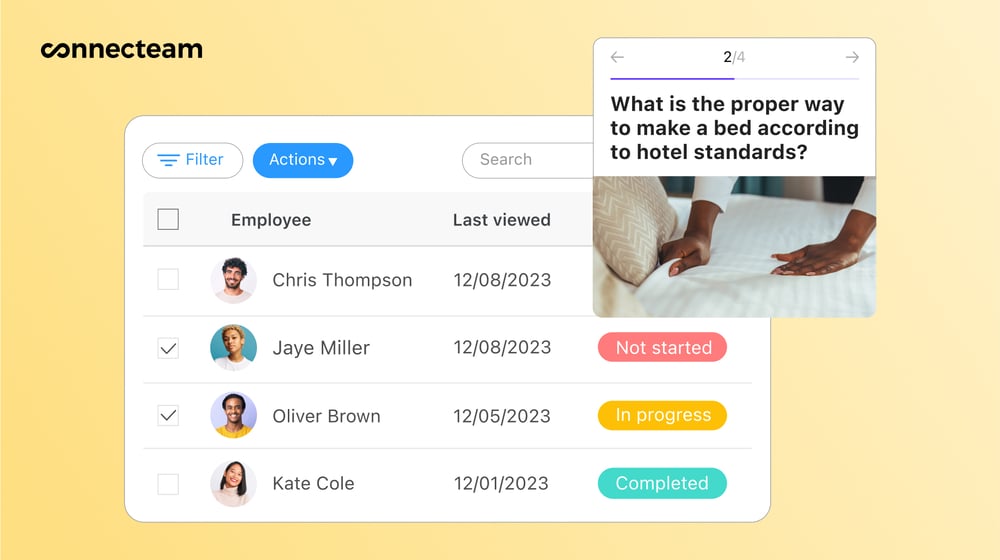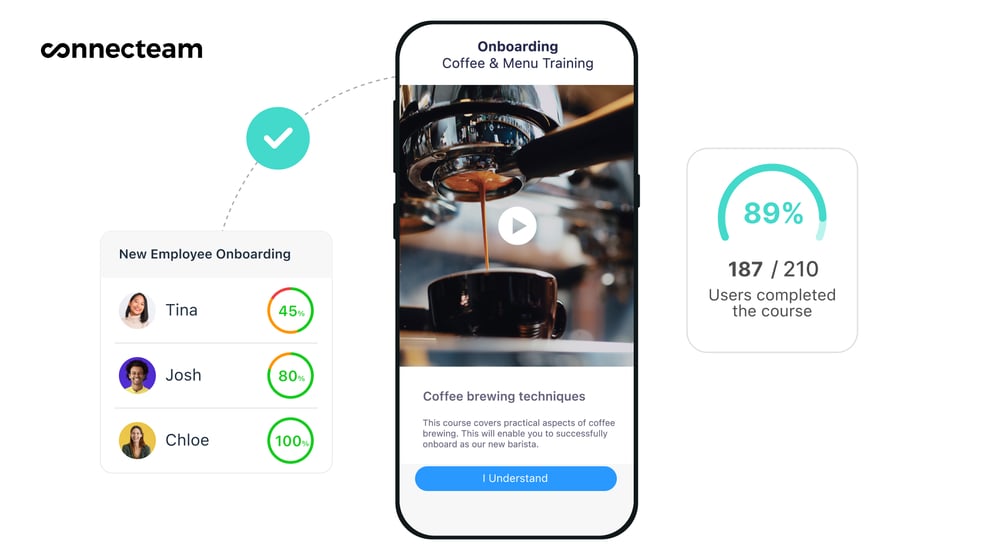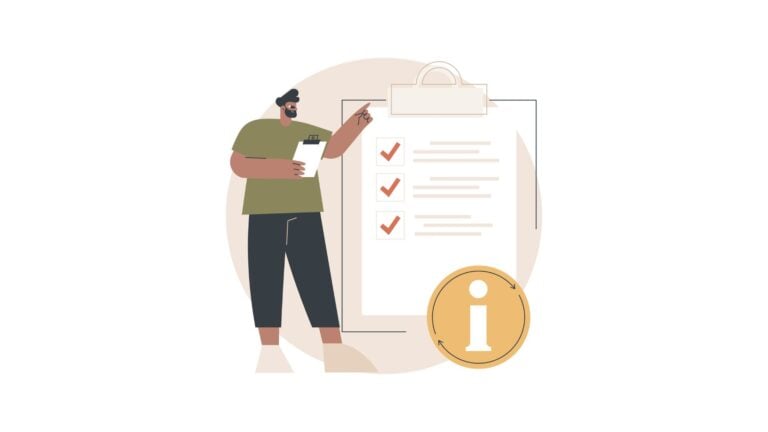Employee training manuals let you keep employees informed, educated, and in compliance. This article details when and why to use training manuals and provides a 10-step process for creating your own.
Creating an effective employee training manual helps you deliver consistent new hire onboarding, ensure everyone at your company is aligned with business goals and values, and equip your employees with the knowledge they need to be successful in their roles.
You can use training manuals for various purposes, and they can cover a range of topics, workflows, best practices, and more. However, as important as they are and as versatile as they can be, creating one of these manuals can be tricky.
In this article, we walk you through the 10 steps to create and implement an employee training manual of your own. We also explain how Connecteam can streamline the process.
Key Takeaways
- Employee training manuals provide guidance and information on policies, procedures, workflows, and more. They’re commonly used for onboarding, continued learning, compliance training, and product or systems training.
- These manuals lead to increased worker knowledge and resourcefulness, more consistent performance, less time and money expended, and fewer mistakes.
- You can create a training manual by identifying objectives, defining your audience, and determining its format, structure, and content. Then, test it out with a sample group, adjust it, publish it for everyone, and gather feedback.
- Connecteam can help you develop your company’s training manuals. Create customized training content, store it in a centralized location, share it with unlimited users, and track learner progress and knowledge.
What Is a Training Manual and What Is Its Purpose?
A training manual is a comprehensive document that offers instructions and information about a process, workflow, or subject.
There’s no standard format for these manuals. Some offer step-by-step instructions, some provide visuals like flow charts, and others are long-form documents.
Many companies provide training manuals for employees so they can easily access job-related information—no matter if they’re new hires or have been with the company for years.
A few of the most common times to use a training manual include:
- New hire onboarding. As employees join the company, a training manual makes it easy to get up to speed on role requirements, expectations, systems the business uses, and company policies and procedures.
- Continued learning. Even experienced employees need a refresher now and then. It’s important to provide training manuals so workers can refer to best practices and processes.
- Compliance and regulatory training. Training manuals on topics like sexual harassment, discrimination, insider training, cybersecurity, and on-the-job safety help keep your company in line with legal requirements.
- Product or systems training. When you implement a new system or product at your business, employees need to know how to use it properly. Equip them with this information by creating a training manual with step-by-step instructions for optimal use.
Beyond employee training, there’s often a need for training manuals to inform customers on how to use your company’s products or services.
The Benefits of Training Manuals
Provide consistency to your team
A good training manual allows all employees to experience the same training, reducing the likelihood of confusion or mistakes.
When important processes or procedures are documented for the entire team, you can trust that everyone works from the same playbook and follows the same instructions. This also assures the team that they’re following the right steps.
Streamline the onboarding process
Using a training manual lets you save time on new hire onboarding. You can ensure every employee receives the same standard information and is set up on the right foot from day 1. The sooner employees learn the details of their role, the sooner they can start providing value.
Employees can be onboarded faster and more productively with effective training material—whether they need to understand policies, processes, and procedures or undergo in-depth training on your company’s products or services.
💡Pro Tip:
Upload your employee training manual into a digital knowledge base like Connecteam so your team can access it easily and on the go. Connecteam helps you create, organize and share your business’ files in one place and make everything accessible to your staff in a breeze!
Foster resourcefulness, performance, and independence
Employees will be more resourceful when solving problems and learning new skills when they know there are effective training manuals and where to find them.
They can refer to the manual rather than coming to you or another manager to ask for help. This saves everyone time and builds up team members’ confidence and independence as they successfully find solutions on their own.
Employees who are well-trained and confident in their knowledge of their job are also likely to perform better, be more productive, and remain engaged.
Increase compliance and safety
The best way to guarantee your team follows regulations is to ensure they’re armed with the right information and steps to follow. Creating a training manual is an excellent way to outline these procedures and protocols to avoid compliance issues or lawsuits.
You can even provide training videos alongside a written manual so employees have a live, real-world representation of how to adhere to requirements.
💡Pro Tip:
Once you’ve trained your team, you can use standard operating procedures (SOP) software to help them track and adhere to regulations. Looking for the top options? We review the best SOP software in 2025.
Reduce mistakes
A detailed training program puts important information directly into employees’ hands. You won’t have to worry that an employee might forget how to properly execute a task, document a job, or follow protocols and procedures.
Avoiding mistakes minimizes the need to redo work and helps improve the quality of work overall.
It also helps you avoid paying for fines or overtime hours. For example, proper training makes it more likely that work will be done right the first time. This prevents you from having to pay an employee overtime to stay late and fix it. It also keeps employees informed of proper procedures, especially regarding safety or compliance, which limits the risk of fines for violations.
Save money on training costs
Training manuals can help your business save money. Firstly, it provides a consistent way for you to train everyone on a specific topic. You won’t need to pay to create and provide individualized training sessions or training videos. Instead, you can condense that information into a single source that all your employees can use.
Additionally, since employees can always refer to a training manual, you won’t need to spend money creating refresher courses or microlearning sessions to get employees up to speed if they forget information.
How to Create an Employee Training Manual in 10 Steps
While the exact process may vary depending on your company’s needs, creating a training manual is as easy as following 10 general steps.
Step 1: Identify training and knowledge objectives
The first thing you need to do is figure out what knowledge you want to teach through this training. Think about the most important objectives you want employees to achieve. What skills should they learn or develop? What information should they learn?
It’s helpful to write down a few specific goals. For example: “After reading this manual, employees will understand the exact process to sign up for employee benefits.” Or, “This training will arm team members with specific instructions for filling out their performance self-review.”
📚 This Might Interest You:
Check out our guide to starting effective employee training programs, then learn how to set realistic training objectives for your team.
Step 2: Define the target audience
Next, think about the target audience. Consider who needs this knowledge or who will benefit from these instructions.
You’ll want to consider things like experience level, role, and background. For example, a senior employee likely has different knowledge than a junior worker, so be aware of what sort of training each worker can benefit from.
Similarly, employees in different positions will have different skills and understandings. For instance, you may include technical information in a training manual for engineers, but it would likely cause confusion in a manual for HR professionals.
When defining your audience, you should also think about the objectives you set. For example, the biggest objective may be improving safety in your warehouse. Your target audience will be anyone who spends time working there. Or maybe you’re aiming to build a management team full of excellent coaches. Your target audience would be workers who are already in management or interested in a promotion.
Step 3: Gather resources and information
Before you’re ready to create your training manual, make sure you have all the necessary information.
For example, for a training manual about a specific company procedure, gather all existing documentation of the procedure and any relevant processes. For software or system training, you’ll want to have any manuals or implementation guides handy. To create a safety training manual, be sure to look up any regulations or codes.
This is also a great time to consult with any internal or external subject matter experts. Those who are closely involved with the topic of the training can provide insight, ideas, and best practices you may not have thought of.
Step 4: Choose a format and structure

Next, decide how to format and structure your manual.
Choose the best format
There are numerous types of training materials out there, so you have plenty of formats to choose from.
You can write up a document, create a slide deck (like a PowerPoint or Google Sheets presentation), or use an interactive learning management system (LMS) to create your manual.
Ultimately, choose what works best for the type of training you’re providing and your target audience.
For example, you might use a slide deck for a manual that includes many visuals, like workflows and infographics for a safety-focused manual. For a manual HR employees can refer to as needed, a document makes it easy for them to locate the information they need.
Structure your manual
No matter how you present the information, you’ll need a strong outline of the content itself. Create an outline that breaks down the content into small, easy-to-digest pieces.
Start by creating headings for each section—including an introduction to the training to explain what a user can expect to learn, a table of contents, and a conclusion that summarizes what’s been covered.
As you create your manual, focus on a simple and accessible design. You don’t want the training content to be lost among too many colors or styles. Stick to your company’s brand style or only use a couple of different colors. This helps make the manual easier to read.
Also, ensure you use the same easily readable font throughout. A sans-serif font like Arial is a safe option. Use only a couple of different font sizes as needed for titles, headings, subheadings, main text, etc.
Include visual aids
Effective training material includes visual aids. Even if your training is mostly text-based, including a few visual aids is a helpful way to convey information, especially to those who are visual learners.
Consider adding images that show how to execute a process—like flowcharts or explanatory diagrams—or illustrations to keep employees engaged. Tables can help you display large amounts of information in a digestible way.
Images can make your manual more visually interesting, but avoid using too many. They can draw attention away from more important information and make your content look cluttered.
Step 5: Draft and edit the content
Refer to the outline you created and start filling in the blanks. Flesh it out as needed, especially if you uncovered new information when speaking with SMEs or reviewing documents.
Use the desired end result as your guide. In order for an employee to come away fully trained, what do they need to learn? What do you need to explain to them?
Keep in mind the sequence of information so that it flows in a logical manner. Start from the beginning and build on the topic throughout the training.
As an example, say you’re creating a training manual about safety procedures. You might:
- Start with an introduction about why safety is important and how these procedures increase safety at your company.
- Dive into the “meat” of the training to explain everything your employees need to know.
- Finish up with a summary and steps. What should your employees do next? How should they proceed now that they’ve been trained?
Additionally, remember to consider your audience as you draft your content. Avoid overly-specific or technical jargon if you’re training a general audience. Also, keep everything in the training relevant to the audience at hand.
For example, avoid role-specific jargon in a training manual meant for your entire company. Instead, use language that everyone will understand regardless of their position. On the other hand, for training focused on a process that only applies to 1 team, you can tailor the manual to be more specific to that team’s knowledge.
After you’ve written your content, read it and make edits as necessary.
💡 Pro Tip:
Of course, it’s important to be mindful of grammar or formatting errors when editing your manual. But you should also consider having a colleague or supervisor read through it to ensure everything is accurate and understandable.
Step 6: Deliver a test manual and make changes as needed
Before doing a company-wide rollout, test it out with a small subset of the company. You might choose members of a specific department, members of leadership, or even 1-2 people from cross-functional teams to get a well-rounded group.
Ask them to read the training manual, and then ask for their feedback. Send them a survey, asking questions like:
- What did you take away from this training?
- After reading the manual, how would you rate your understanding of the topic?
- How relevant is this training to your role? How will it help you improve on the job?
- Was there anything you hoped to learn but didn’t?
- What suggestions do you have for future additions or changes to this training?
Once you collect their feedback, analyze the responses to understand themes and areas for improvement. Use that information to make changes to the manual before publishing it to everyone.
Step 7: Roll out to all employees
Congratulations, your training manual is ready for publication! Now it’s time to share with your employees.
Start by communicating the new resource to your team. Explain why the manual exists, how it can help them, and where they can access it.
Consider using a multi-pronged communication strategy. Send an email, share the manual in your company messaging app, and publish it to your internal knowledge base or wiki page. This covers all the bases and ensures no one misses the information. It also gives employees various options for where they can access the manual.
Step 8: Track progress

As employees work through the training manual, it can be helpful to keep track of their progress and completion.
You won’t need to track progress for every manual. It depends on the type of training. Manuals that are meant to be referred to as needed or those that teach users how to use a specific software don’t typically require progress tracking.
You will, however, want to track progress for training required for regulatory or compliance reasons or manuals that offer new information.
Step 9: Test employees’ knowledge

Consider adding quizzes or other interactive elements to your training manual. These help test employees’ knowledge and keep them engaged.
Refer to the main knowledge objectives you noted, then build out your quiz and include questions to assess that knowledge. You can set quizzes to appear throughout the manual or just at the end. You can even require employees to pass a quiz before officially finishing the training manual.
Step 10: Collect feedback and update over time
Just as you did when you did a trial run of your manual, you’ll want to request employee feedback to make improvements to your training manual.
A survey works well here, too. You can even consider conducting 1 survey before employees read the manual and 1 after.
An example of the initial survey might include questions like:
- What do you hope to learn from this training manual?
- On a scale of 1-5, how would you rate your current understanding of the topic?
For the post-training survey, you can use similar questions to those you used in your test-run survey. You can gauge how much they’ve learned and collect any feedback or suggestions they may have.
Analyze these answers and update the training manual as needed.
How Connecteam Can Help You With Training
Connecteam is an all-in-one work management platform that includes everything you need to deliver engaging employee training.
Create custom employee training materials and courses
With Connecteam, you can easily create full training courses, bite-sized videos, customized training manuals, and other materials.
Use templates or create materials and courses from scratch. You can include PDFs, videos, forms, images, infographics, and more and break courses up into easily digestible modules.
Plus, as things change, it’s easy to revise and update your training content as needed.
Employees can use the Connecteam mobile app to access training information from anywhere, at any time. This encourages continuous learning and can help boost their confidence and independence.

Store all information in one place
When you use Connecteam to create training materials, you can securely store all the information in a central knowledge base.
Employees can refer to training materials—and any other important company documents—whenever they need to. This single source of truth means no one has to spend time hunting down information from various locations.
Track progress and test knowledge

Connecteam makes it easy to keep track of employees’ training progress. Simply view the central dashboard to see how far along in training each worker is. Connecteam enables you to send auto-reminders to employees to encourage them to complete training.
Additionally, interactive quizzes let you check team members’ knowledge so you’ll be sure they get what they need from the training.
As employees finish training and pass in-app quizzes, you can reward their achievements with recognition badges or digital tokens.
Asking for feedback is a snap
Connecteam’s surveys and polls feature enables you to quickly and easily gather feedback from employees. You can create and share surveys and polls right in the app, and employees can respond from anywhere.
Use templates or create your own custom surveys with yes/no, rating scale, open-ended, and multiple choice questions. View results in real time straight from your mobile device and send employees smart alerts reminding them to fill out the survey before the deadline.
No limits on employee training
With the ability to create unlimited training and share it with unlimited users, Connecteam grows with your company—whether you have 10, 100, or 10,000 employees. Never worry about running out of storage space or having to pay extra for more learners.
Conclusion
Creating employee training manuals leads to easier onboarding, stronger employee performance, better consistency, and fewer mistakes. With this guide, you’re ready to follow 10 steps to design and implement your own training manual.
You can use Connecteam for all your employee training needs—from creating materials to gathering feedback. Your employees will appreciate the ease of accessing materials on the go, and you’ll benefit from having knowledgeable, skilled workers. Plans start at just $29 per month for up to 30 users, and small businesses with 10 or fewer employees can use Connecteam 100% free for life.
FAQs
What should be included in training materials?
Employee training materials should include written content, visual aids to illustrate processes and workflows, and video demonstrations. A best practice is to also include tests or quizzes to check employees’ knowledge.
What tools are used for training employees?
There are many digital tools you can use for employee training. However, it’s important to select one that offers customization options, written and visual content, unlimited users, and on-the-go access. Connecteam is an excellent choice for an all-in-one training solution.




